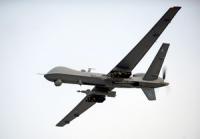-
Mimicking peregrine falcon attack strategies could help down rogue drones
Researchers have discovered that peregrine falcons steer their attacks using the same control strategies as guided missiles. The findings, which overturn previous assumptions that peregrines’ aerial hunting follows simple geometric rules, could be applied to the design of small, visually guided drones that can take down other ‘rogue’ drones in settings such as airports or prisons.
-
-
Israel warned Assad it will take action to prevent Iran’s military presence in Syria
Israel passed a message to Syrian president Bashar al-Assad through an intermediary that it would take military action in Syria if Iran is allowed to establish a permanent military presence in Syria. Israel has not intervened in the Syrian conflict, but has taken action to prevent the transfer of sophisticated weapons to Hezbollah and to prevent military infrastructure being established on its border.
-
-
Should we fear the rise of drone assassins? Two experts debate
A new short film from the Campaign Against Killer Robots warns of a future where weaponized flying drones target and assassinate certain members of the public, using facial recognition technology to identify them. Is this a realistic threat that could rightly spur an effective ban on the technology? Or is it an overblown portrayal designed to scare governments into taking simplistic, unnecessary and ultimately futile action? Two academics offer their expert opinions.
-
-
Revolutionizing subterranean mapping and navigation
Subterranean warfare—whether involving human-made tunnels, underground urban infrastructure, or natural cave networks—has been an element of U.S. military operations from the Second World War and Vietnam to Iraq and Afghanistan. As above-ground commercial and military intelligence, surveillance, and reconnaissance (ISR) capabilities continue to grow more capable and ubiquitous, adversaries are increasingly heading underground to circumvent detection. Rapid global urbanization, furthermore, is accelerating the frequency and complexity of dangerous subterranean environments faced not just by warfighters, but also by emergency responders performing search-and-rescue missions underground: in collapsed mines, for instance, or municipal or urban settings wrecked by natural disaster. DARPA issues a Request for Information which seeks concepts for novel systems and component technologies to disruptively augment military and civilian operations underground.
-
-
Why nuclear deterrence could work on North Korea
The same logic that kept a nuclear war from breaking out between the United States and former Soviet Union is the best strategy to now pursue with North Korea, several scholars said last week at Stanford. The discussion revolved around whether North Korea will have the ability to strike the U.S. with nuclear warheads, and can the U.S. depend on a deterrence strategy like it did during the Cold War? Deterrence theory holds that nuclear weapons are intended to deter other states from attacking with their nuclear weapons, through the promise of retaliation and possibly mutually assured destruction.
-
-
Russia vetoes UN chemical weapons investigation in Syria
In an effort to protect the Assad regime from more damaging revelations about the regime’s use of chemical weapons, Russia, on Thursday and Friday, vetoed two resolutions to extend the mandate of Joint Investigative Mechanism (JIM), set up by the UN to investigate the use of chemical weapons in the Syrian civil war. JIM’s mandate expired on Friday.
-
-
Counter UAVs to drive enemy drones out of the sky

Defense drones to seek out and bring down hostile military UAVs are being developed in Australia. Military drones have changed the landscape of the modern battlefield in recent years, but the technology to counter them has not kept pace. Reacting to this gap in the market the startup is developing two models in Adelaide, South Australia. The first is a compact counter UAV drone with metal rotors that can be stored in a soldier’s pack and launched when an enemy drone is believed to be in the area.
-
-
Counter UAVs to drive enemy drones out of the sky
Defense drones to seek out and bring down hostile military UAVs are being developed in Australia. Military drones have changed the landscape of the modern battlefield in recent years, but the technology to counter them has not kept pace. Reacting to this gap in the market the startup is developing two models in Adelaide, South Australia. The first is a compact counter UAV drone with metal rotors that can be stored in a soldier’s pack and launched when an enemy drone is believed to be in the area.
-
-
Employing plants as discreet, self-sustaining sensors to warn of security threats

Few military requirements are as enduring as the need for timely, accurate information. To meet this demand, the Department of Defense invests heavily in the development of powerful electronic and mechanical sensors, and in the manpower to maintain and operate those sensors. DARPA notes that nature, the master of complexity, offers potential solutions, and that the agency new Advanced Plant Technologies (APT) program looks to seemingly simple plants as the next generation of intelligence gatherers. The program will pursue technologies to engineer robust, plant-based sensors that are self-sustaining in their environment and can be remotely monitored using existing hardware.
-
-
New mapping software makes live-fire training safer
Better to protect soldiers and sailors during live-fire training, the Office of Naval Research’s (ONR) TechSolutions program has sponsored the development of a new Google Maps-style software tool to map out training areas in great detail. This “geospatial-awareness” tool is designed to plug into the U.S. Marine Corps’ KILSWITCH—the Kinetic Integrated Lightweight Software Individual Tactical Combat Handheld for Android.
-
-
Developing autonomous drone swarms for urban warfare
DoD has awarded a team of researchers $7.1 million to develop a drone swarm infrastructure to help the U.S. military in urban combat. The goal is to develop a technology which would allow troops to control scores of unmanned air and ground vehicles at a time.
-
-
NATO launches Cyber Operations Center
Russia’s successful cyber-interference on behalf of its favored candidates, partiers, and causes in the United States, France, the Netherland, Germany, and the United Kingdom; its effective cyberattacks on infrastructure facilities in Ukraine and the Baltic states; and the growing cyberthreats from China, North Korea, and Iran, have convinced the member states of NATO that these threats must be met in a more systematic and comprehensive fashion.
-
-
Israel demolishes Gaza tunnel, killing 9 Palestinian militants
The Israel military (IDF) on Monday morning destroyed a tunnel Hamas fighters were building under the Israel-Gaza Strip. The Hamas Health Ministry in Gaza said that nine Palestinians were killed and eight others were wounded when the IDF blew up the tunnel. Israel this summer began work on an underground barrier meant to counter attack tunnels.
-
-
EU set to define cyberattacks as “acts of war,” allowing collective military response
In Response to Russian interference in the electoral campaigns in Germany, France, and the Netherlands, and the North Korean WannaCry attack on the U.K. health services, EU governments are planning to sign a declaration – officially titled “The framework on a joint EU diplomatic response to malicious cyber activities” — which defines cyberattacks on any EU country as an act of war, potentially triggering a military retaliation – even including conventional arms – in response. The proposed EU declaration would be similar to a change NATO made to the treaty governing NATO operations: In 2014, NATO updated its cyber defense policy, to make an explicit link between cyberattacks at a certain threshold and the invocation of a NATO’s article 5 collective defense as part of the treaty.
-
-
Assad regime behind April 2017 sarin attack on Sunni civilians: UN
A new report, released Thursday by the Organization for the Prohibition of Chemical Weapons (OPCW), the UN chemical weapons watchdog, has found that the forces of Syrian President Bashar al-Assad were behind the deadly chemical weapons attack which killed more than ninety people in the village of Khan Sheikhoun on 4 April 2017. The Syrian regime’s use of chemical weapons against Sunni civilian triggered a U.S. retaliation – fifty-nine Tomahawk cruise-missiles launched against the airbase from which the planes carrying the chemicals took off for the mission.
-
More headlines
The long view
Tantalizing Method to Study Cyberdeterrence
By Trina West
Tantalus is unlike most war games because it is experimental instead of experiential — the immersive game differs by overlapping scientific rigor and quantitative assessment methods with the experimental sciences, and experimental war gaming provides insightful data for real-world cyberattacks.
Testing Cutting-Edge Counter-Drone Technology
Drones have many positive applications, bad actors can use them for nefarious purposes. Two recent field demonstrations brought government, academia, and industry together to evaluate innovative counter-unmanned aircraft systems.
European Arms Imports Nearly Double, U.S. and French Exports Rise, and Russian Exports Fall Sharply
States in Europe almost doubled their imports of major arms (+94 per cent) between 2014–18 and 2019–23. The United States increased its arms exports by 17 per cent between 2014–18 and 2019–23, while Russia’s arms exports halved. Russia was for the first time the third largest arms exporter, falling just behind France.
How Climate Change Will Affect Conflict and U.S. Military Operations
By Doug Irving
“People talk about climate change as a threat multiplier,” said Karen Sudkamp, an associate director of the Infrastructure, Immigration, and Security Operations Program within the RAND Homeland Security Research Division. “But at what point do we need to start talking about the threat multiplier actually becoming a significant threat all its own?”
The Tech Apocalypse Panic is Driven by AI Boosters, Military Tacticians, and Movies
By Matthew Guariglia
From popular films like a War Games or The Terminator to a U.S. State Department-commissioned report on the security risk of weaponized AI, there has been a tremendous amount of hand wringing and nervousness about how so-called artificial intelligence might end up destroying the world. There is one easy way to avoid a lot of this and prevent a self-inflicted doomsday: don’t give computers the capability to launch devastating weapons.
